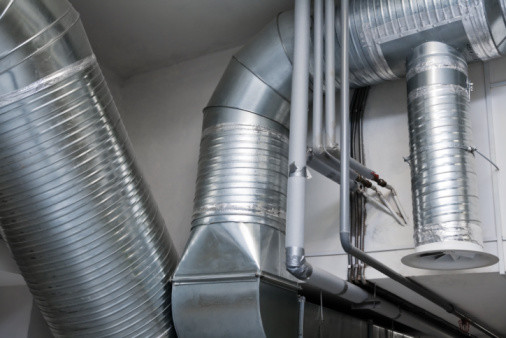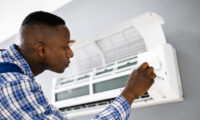What Air Ducts Do
Air ducts are responsible for the distribution of air to the many rooms throughout the home. Part of heating and cooling the interior of the home also involves the air conditioning sucking air through the air ducts, where it is either warmed or cooled to meet the demand of occupants. To operate optimally, air ducts need to be able to carry out the entirety of their functions unhindered. If this is not a possibility, then the circulation of cool or warm air within homes will occur less efficiently and the effectiveness of the system responsible for controlling the temperature will be minimized. Thus, air duct cleaning is a necessity.
Health Implications Of Air Duct Cleaning
In addition to improving the efficiency of the ventilation system within homes, many have concluded that air duct cleaning can actually prevent the development of health problems over time. And while a dirty air duct can act as a distribution method for contaminants and should be addressed, the trace amounts of dust within an air duct is normal and does not require immediate cleaning action. As the effects of cleaning air ducts has been examined over time, the general consensus is that the benefits to health are still relatively unknown, a claim supported by the Environmental Protection Agency. The cleaning of an air duct should be addressed in the event of serious contamination but for standard circumstances, the true effect of air duct cleaning is still being examined.
The DIY Process of Cleaning Air Ducts
The DIY Process of Cleaning Air Ducts Requires Several Items:
- Vacuum Cleaner – When selecting a vacuum cleaner for your ducts, choose one with a forceful hose
- Dust Brush – The dust brush should be durable and should be equipped with thick bristles to maximize its effectiveness
- Drill – In order to remove the registers, you will need a drill that includes Phillips and flathead bits to undo the fasteners
- Microfiber Cleaning Cloth – This cleaning cloth is necessary to wipe down the interior of the duct after it has been vacuumed
- Dryer Vent Brush – This will be attached to the drill and its purpose is cleaning out the lint within the ducts
How to DIY Clean Your Air Ducts
For floor registers, the DIY process of cleaning them out begins relatively simply as they can be pulled up. Any wall registers will have to be unscrewed with the use of the drill. From there you will want to wash the registers, which can be done in the dishwasher for metal registers unless they have been painted, in which case they will have to be hand washed.
After cleaning the registers, you will begin cleaning the interior of the ducts by attaching the vent brush to the drill. To avoid losing it within the ducts as you clean, make sure that the brush is secured tightly onto the drill. From there, activate the drill and pull it back out being careful to cut it off with one to two feet to spare to prevent the dust that is being cleaned out from going everywhere. This should be followed up with the vacuum cleaner and its hose and brush.
Once again, confirm that the brush is secured on the vacuum cleaner and stick it within the duct. Activate the vacuum cleaner and remove any buildup remaining inside of the duct along with the lint that was broken up. Afterwards you will likely want to vacuum off the brush as well and repeat with the other ducts. To finish off cleaning out your air duct, use the microfiber cleaning cloth to get into the duct and hand wipe the interior. This will require you to give the cleaning cloth a thorough wash repeatedly afterwards. After that, confirm that there is no leftover residue around the openings and return the registers to their place.
Want Another DIY Challenge? Check for Leaks
In addition to build up contributing to less efficient ventilation, homeowners may find their air conditioning or furnace could be unnecessarily costing them more than they should be. The likely cause of this is leaks that may be present in your ductwork that not only run up electricity bills but can also have a detrimental effect on the environment, stemming from the waste. Though some leaks are obvious because they can be seen as clear cracks in the ductwork and frequently appear around the joints, not all leaks, even ones that drain serious electricity and harm your comfort, are that obvious. Addressing them is a matter of finding them and putting an end to them.
Buy a Smoke Pencil or Incense Stick
A foolproof method for finding leaks in your home’s ductwork requires a smoke pencil or incense stick. From there, you will need to activate your heat or air conditioning so that there is air blowing out. In order to find the leak, you will have to go into either your attic or your basement with the pencil or stick and proceed to light it. Hold it near the ductwork, especially the joints where leaks often lurk. The smoke pencil and incense stick are necessary because often leaks are smaller, so they won’t be able to be felt by hand alone. If the smoke quickly blows away near a spot, it will alert you to the presence of a leak.
Leaky Ducts in Your Walls
Leaky ducts in walls is where things can get tricky. For those up for the DIY challenge, there is the possibility to isolate the leaks but it is important to note that the going may be tough. Many HVAC pros themselves have a difficult time finding those smaller leaks in walls. If you want to try to DIY, find your air handler. Partition the supply side from the return side with cardboard and masking tape, then by simply using a blower door and pressure pan, you can take a reading at each register. Because your ductwork is supposed to be a closed system, each register should show a reading of 0.
DIY Not Working? Bring In A Professional
At the end of the day, you may not be able to DIY and isolate those leaks that are deep inside your walls. When all DIY efforts have been exhausted, the best thing to do is call up a contractor. Not all HVAC pros are good at isolating ductwork leaks, so do your research. Asking a potential contractor something as simple as, “How would you go about isolating a ductwork leak?” can shed valuable insights.
It is also helpful to look for an HVAC pro with a couple decades of experience. Check their reviews out online, and look for 4 stars or more. Confirming that they have an A+ BBB rating will also be a good metric for a professional’s capability.
DIY Air Duct Cleaning is Worth the Work
Cleaning out the air ducts in your home does not necessarily have to be left to professionals as it is possible to DIY. While the DIY maintenance process does require some tools and a bit of elbow grease, cleaning out the ducts will offer you clean air, improve your airflow and the overall efficiency of your system, and help you save money.










